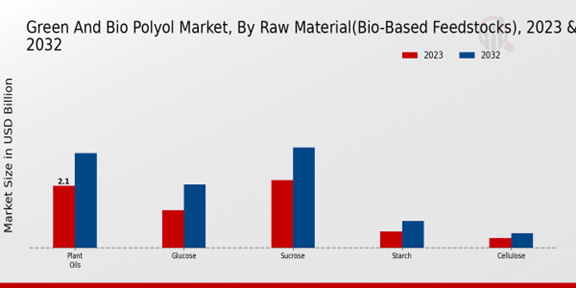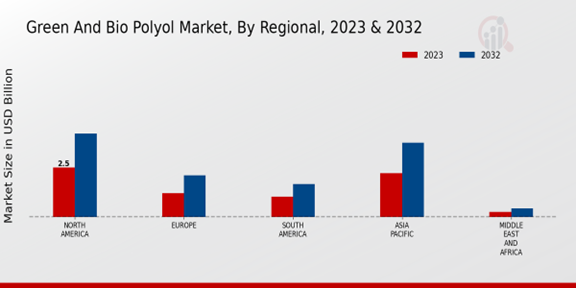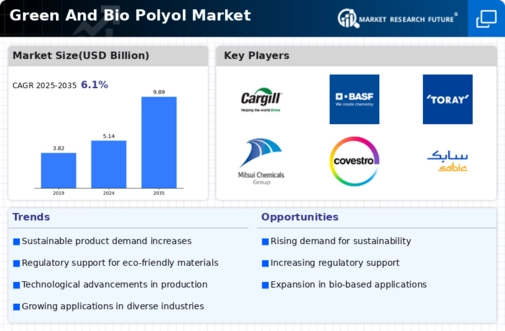Kindly complete the form below to receive a free sample of this Report

Green Bio Polyol Market
Marktforschungsbericht zu grünen und biologischen Polyolen nach Rohstoffen (biobasierte Rohstoffe) (Pflanzenöle (Sojaöl, Palmöl, Rizinusöl), Glucose, Saccharose, Stärke, Zellulose), nach Produkttyp (biobasierte Polyethylenpolyole, Bio -basierte Polypropylenpolyole, biobasierte Polyurethanpolyole, biobasierte Polyesterpolyole, biobasierte Polyetherpolyole), nach Anwendung (Isolierung). Schäume, Hartschäume, flexible Schäume, Kleb- und Dichtstoffe, Beschichtungen, Kunststoffe), nach Endverbrauchsindustrie (Bau, Automobil, Möbel, Verpackung, El... read more
Überblick über den globalen Markt für grünes und biologisches Polyol
Die Marktgröße für grünes und biologisches Polyol wurde im Jahr 2022 auf 4,3 Milliarden US-Dollar geschätzt. Es wird erwartet, dass die Industrie für grünes und biologisches Polyol von 4,57 Milliarden US-Dollar im Jahr 2023 auf 7,8 Milliarden US-Dollar im Jahr 2032 wachsen wird. The Green Und die CAGR (Wachstumsrate) des Biopolyol-Marktes wird im Prognosezeitraum (2024 – 2024) voraussichtlich bei etwa 6,13 % liegen. 2032).
Wichtige Markttrends für grünes und biologisches Polyol hervorgehoben
Biobasierte Polyole, die aus erneuerbaren Ressourcen wie Pflanzenölen oder Biomasse gewonnen werden, erfreuen sich aufgrund zunehmender Umweltbedenken und Nachhaltigkeitsinitiativen zunehmender Beliebtheit auf dem Markt für grüne und Bio-Polyole. Sie bieten umweltfreundliche Alternativen zu herkömmlichen Polyolen auf Erdölbasis, reduzieren den CO2-Fußabdruck und fördern Praktiken der Kreislaufwirtschaft. Es wird erwartet, dass sich dieser Trend fortsetzt, da Verbraucher und Industrie nach nachhaltigen Lösungen suchen. Zu den wichtigsten Markttreibern zählen die steigende Nachfrage nach umweltfreundlichen Produkten, staatliche Vorschriften zur Förderung biobasierter Materialien und technologische Fortschritte bei der Biopolyol-Produktion. Chancen liegen in der Entwicklung neuer biobasierter Polyole mit verbesserter Leistung und Kosteneffizienz sowie in der Erforschung von Anwendungen in verschiedenen Branchen wie der Automobil-, Bau- und Verpackungsindustrie. Jüngste Trends deuten auf eine Verlagerung hin zu pflanzenbasierten Biopolyolen hin, insbesondere solchen, die daraus gewonnen werden aus Soja-, Raps- und Palmöl. Der Markt verzeichnet auch eine wachsende Nachfrage nach Biopolyolen für Hochleistungsanwendungen, wie z. B. Hartschäume zur Isolierung und leichte Verbundwerkstoffe für Automobilteile. Da Nachhaltigkeit zu einem integralen Bestandteil von Geschäftsstrategien wird, wird erwartet, dass der Markt für grüne und biologische Polyole in den kommenden Jahren ein deutliches Wachstum verzeichnen wird.
Quelle: Primärforschung, Sekundärforschung, MRFR-Datenbank und Analystenbewertung
Grüne und Bio-Polyol-Markttreiber
Steigende Nachfrage nach umweltfreundlichen Materialien
Das zunehmende Bewusstsein für die Umweltauswirkungen traditioneller Materialien hat zu einer wachsenden Nachfrage nach umweltfreundlichen und biobasierten Alternativen geführt. Grüne und Bio-Polyole werden aus erneuerbaren Ressourcen gewonnen und bieten eine ähnliche oder bessere Leistung als Polyole auf Erdölbasis. Dies hat sie zu einer attraktiven Option für Hersteller gemacht, die ihren ökologischen Fußabdruck reduzieren möchten. Es wird erwartet, dass die Branche des Marktes für grüne und biologische Polyole in den kommenden Jahren einen erheblichen Nachfrageanstieg verzeichnen wird, der auf die zunehmende Einführung umweltfreundlicher und nachhaltiger Praktiken in verschiedenen Branchen zurückzuführen ist. Die Bauindustrie ist ein Hauptverbraucher von Polyolen, und die Tendenz steigt Es wird erwartet, dass die Nachfrage nach umweltfreundlichen Gebäuden die Nachfrage nach grünen und Bio-Polyolen ankurbeln wird. Grüne Gebäude sind darauf ausgelegt, die Auswirkungen auf die Umwelt zu minimieren, und die Verwendung von grünen und Bio-Polyolen kann dazu beitragen, den CO2-Fußabdruck dieser Gebäude zu verringern. Die Automobilindustrie ist ein weiterer großer Abnehmer von Polyolen, und die steigende Nachfrage nach leichten und kraftstoffeffizienten Fahrzeugen wird voraussichtlich die Nachfrage nach grünen und Bio-Polyolen ankurbeln. Grüne und Bio-Polyole können dazu beitragen, das Gewicht von Fahrzeugen zu reduzieren und so den Kraftstoffverbrauch zu verbessern Effizienz. Auch die Verpackungsindustrie ist ein großer Verbraucher von Polyolen, und die steigende Nachfrage nach nachhaltigen Verpackungen dürfte die Nachfrage nach grünen und Bio-Polyolen ankurbeln. Grüne und Bio-Polyole können dazu beitragen, die Umweltauswirkungen von Verpackungen zu verringern und die Haltbarkeit von Produkten zu verbessern. Es wird erwartet, dass die wachsende Nachfrage nach grünen und Bio-Polyolen in den kommenden Jahren anhalten wird, da sich die Verbraucher der Umweltauswirkungen traditioneller Materialien stärker bewusst werden und Hersteller nach nachhaltigeren Alternativen suchen.
Technologische Fortschritte bei der Produktion grüner und biologischer Polyole
Die Entwicklung neuer Technologien hat es ermöglicht, grüne und Bio-Polyole effizienter und kostengünstiger herzustellen. Dies hat sie zu einer attraktiveren Option für Hersteller gemacht, die ihre Kosten senken möchten. Einer der wichtigsten technologischen Fortschritte bei der Herstellung grüner und biologischer Polyole ist die Entwicklung neuer Katalysatoren. Katalysatoren werden verwendet, um die chemischen Reaktionen zu beschleunigen, die bei der Herstellung von Polyolen ablaufen. Die Entwicklung neuer Katalysatoren hat es ermöglicht, grüne und Bio-Polyole schneller und effizienter herzustellen. Ein weiterer wichtiger technologischer Fortschritt bei der Herstellung von grünen und Bio-Polyolen ist die Entwicklung neuer Rohstoffe. Feedstocks sind die Rohstoffe, die zur Herstellung von Polyolen verwendet werden. Die Entwicklung neuer Rohstoffe hat es ermöglicht, grüne und Bio-Polyole aus einem breiteren Spektrum erneuerbarer Ressourcen herzustellen. Dies hat sie zu einer nachhaltigeren Option für Hersteller gemacht.
Regierungsvorschriften und Anreize
Auch staatliche Vorschriften und Anreize tragen dazu bei, das Wachstum der Marktbranche für grüne und biologische Polyole voranzutreiben. Regierungen auf der ganzen Welt setzen zunehmend Vorschriften um, die darauf abzielen, die Umweltauswirkungen der Branche zu verringern. Diese Vorschriften führen zu einer Nachfrage nach umweltfreundlichen und biobasierten Materialien wie grünen und Bio-Polyolen. Regierungen bieten auch Anreize für Unternehmen, die in umweltfreundliche und nachhaltige Technologien investieren. Diese Anreize können dazu beitragen, die Kosten für die Herstellung von grünen und Bio-Polyolen zu senken, was sie zu einer attraktiveren Option für Hersteller machen kann.
Einblicke in das Marktsegment für grünes und biologisches Polyol
Einblicke in den Markt für grüne und Biopolyol-Rohstoffe (biobasierte Rohstoffe)
Es wird erwartet, dass das Rohstoffsegment des Marktes für grüne und biologische Polyole in den kommenden Jahren ein deutliches Wachstum verzeichnen wird, angetrieben durch die steigende Nachfrage nach nachhaltigen und umweltfreundlichen Produkten. Biobasierte Rohstoffe wie Pflanzenöle, Glukose, Saccharose, Stärke und Zellulose erfreuen sich aufgrund ihrer erneuerbaren und biologisch abbaubaren Natur zunehmender Beliebtheit als Alternativen zu herkömmlichen erdölbasierten Materialien. Unter diesen biobasierten Rohstoffen haben Pflanzenöle, insbesondere Sojaöl und Palmöl, aufgrund ihrer hohen Verfügbarkeit und Kosteneffizienz derzeit einen erheblichen Marktanteil. Allerdings wächst das Bewusstsein für die Umweltauswirkungen der Palmölproduktion Es wird erwartet, dass die Nachfrage nach alternativen Pflanzenölen wie Rizinusöl ansteigt, das ähnliche Eigenschaften bietet und als nachhaltiger gilt. Glukose und Saccharose sind weitere wichtige biobasierte Rohstoffe, die bei der Herstellung grüner und biologischer Polyole verwendet werden. Diese Zucker werden aus erneuerbaren Quellen wie Mais und Zuckerrohr gewonnen und sind äußerst vielseitige Rohstoffe, die zur Herstellung einer breiten Palette von Polyolen verwendet werden können. Stärke und Zellulose, die aus Pflanzen wie Mais und Holz gewonnen werden, gewinnen aufgrund ihres Vorkommens und ihrer geringen Kosten ebenfalls zunehmend an Bedeutung als nachhaltige Rohstoffe für die Produktion von Biopolyolen. Die steigende Nachfrage nach biobasierten Polyolen in verschiedenen Endverbrauchsindustrien, einschließlich Automobil, Bauwesen und Verpackung, dürfte das Wachstum des Rohstoffsegments im Markt für grüne und biologische Polyole vorantreiben. Diese Polyole bieten Vorteile wie geringere Umweltbelastung, verbesserte Leistung und längere Haltbarkeit, was sie zu attraktiven Alternativen zu herkömmlichen Polyolen aus fossilen Brennstoffen macht. Die Marktsegmentierung für grünes und biologisches Polyol bietet wertvolle Einblicke in die Dynamik der Branche und hilft Marktteilnehmern, fundierte Entscheidungen zu treffen. Durch das Verständnis der Markttrends und der Leistung verschiedener Segmente können Unternehmen ihre Strategien anpassen, um Wachstumschancen zu nutzen und auf die sich entwickelnden Bedürfnisse einzugehen der Endbenutzer.

Quelle: Primärforschung, Sekundärforschung, MRFR-Datenbank und Analystenbewertung
Einblicke in die Produkttypen des Marktes für grünes und biologisches Polyol
Der Markt für grüne und biologische Polyole ist nach Produkttyp in biobasierte Polyethylenpolyole, biobasierte Polypropylenpolyole, biobasierte Polyurethanpolyole, biobasierte Polyesterpolyole und biobasierte Polyetherpolyole unterteilt. Unter diesen hielten biobasierte Polyetherpolyole im Jahr 2023 den größten Marktanteil und machten über 40 % des Umsatzes auf dem Markt für grüne und biologische Polyole aus. Dies ist auf ihr breites Anwendungsspektrum zurückzuführen, darunter die Herstellung von Weich- und Hartschäumen, Beschichtungen und Klebstoffen. Biobasierte Polyurethanpolyole dürften im Prognosezeitraum aufgrund ihres zunehmenden Einsatzes in der Automobil- und Bauindustrie die höchste Wachstumsrate verzeichnen.
Einblicke in Marktanwendungen für grünes und biologisches Polyol
Der Markt für grüne und biologische Polyole ist je nach Anwendung in Isolierschäume, Hartschäume, flexible Schäume, Kleb- und Dichtstoffe, Beschichtungen und Kunststoffe unterteilt. Aufgrund der steigenden Nachfrage nach energieeffizienten Baustoffen wird im Jahr 2023 das Segment Dämmschäume voraussichtlich den größten Marktanteil halten. Das Hartschaumsegment dürfte im Prognosezeitraum aufgrund seiner zunehmenden Akzeptanz in der Automobil- und Bauindustrie das schnellste Wachstum verzeichnen. Es wird erwartet, dass das Segment der flexiblen Schaumstoffe im Jahr 2023 einen erheblichen Marktanteil ausmachen wird, vor allem aufgrund der Verwendung in Möbel- und Bettwarenanwendungen. Das Segment der Kleb- und Dichtstoffe wird aufgrund der steigenden Nachfrage nach Öko voraussichtlich stetig wachsen -freundliche Klebstoffe in verschiedenen Branchen. Für den Bereich Beschichtungen wird ein moderates Wachstum erwartet, das vor allem auf die wachsende Nachfrage nach nachhaltigen Beschichtungen in der Automobil- und Bauindustrie zurückzuführen ist. Das Kunststoffsegment wird aufgrund der zunehmenden Einführung biobasierter Kunststoffe in verschiedenen Anwendungen voraussichtlich moderat wachsen.
Grüne und Bio-Polyol-Markt-Einblicke in die Endverbrauchsbranche
Das Segment der Endverbrauchsindustrie spielt eine entscheidende Rolle bei der Gestaltung des Marktes für grüne und biologische Polyole. Im Jahr 2023 hatte die Bauindustrie mit über 35 % den größten Umsatzanteil, getrieben durch die wachsende Nachfrage nach nachhaltigen Baumaterialien und Dämmlösungen. Aufgrund des zunehmenden Einsatzes biobasierter Materialien in Fahrzeuginnenräumen und -komponenten wird für die Automobilindustrie in den kommenden Jahren ein deutliches Wachstum prognostiziert. Die Möbelindustrie ist ein weiterer wichtiger Endverbrauchssektor, in dem grüne und Bio-Polyole aufgrund ihrer Umweltfreundlichkeit und Haltbarkeit immer beliebter werden. Es wird erwartet, dass auch die Verpackungs-, Elektronik- und Konsumgüterindustrie zum Marktwachstum beitragen, da die Hersteller versuchen, ihre Umweltbelastung zu reduzieren Verkleinern Sie Ihren Fußabdruck und erfüllen Sie die Verbrauchernachfrage nach nachhaltigen Produkten.
Regionale Einblicke in den Markt für grünes und biologisches Polyol
Der Markt für grünes und biologisches Polyol ist in Nordamerika, Europa, APAC, Südamerika und MEA unterteilt. Aufgrund der Präsenz großer Automobil- und Bauindustrien wird Nordamerika im Jahr 2023 voraussichtlich den größten Marktanteil halten. Europa wird voraussichtlich der zweitgrößte Markt sein, gefolgt von APAC. Aufgrund der steigenden Nachfrage nach umweltfreundlichen und nachhaltigen Produkten in der Region wird im Prognosezeitraum voraussichtlich die APAC-Region die höchste Wachstumsrate verzeichnen. Das Wachstum des Marktes wird auf die steigende Nachfrage nach umweltfreundlichen und nachhaltigen Produkten, das wachsende Bewusstsein für Umweltbelange und die zunehmende Akzeptanz von Bio-Ba zurückgeführtsed Materialien in verschiedenen Branchen wie Automobil, Bauwesen und Verpackung.

Quelle: Primärforschung, Sekundärforschung, MRFR-Datenbank und Analystenbewertung
Hauptakteure und Wettbewerbseinblicke auf dem Markt für grünes und biologisches Polyol
Große Akteure auf dem Markt für grünes und biologisches Polyol sind ständig bestrebt, innovative Produkte und Technologien zu entwickeln, um sich einen Wettbewerbsvorteil auf dem Markt zu verschaffen. Führende Marktteilnehmer für grünes und biologisches Polyol investieren stark in Forschung und Entwicklung und konzentrieren sich dabei auf Nachhaltigkeit und Umweltfreundlichkeit. Strategische Kooperationen und Partnerschaften zwischen Unternehmen werden immer häufiger und ermöglichen ihnen den Austausch von Wissen, Ressourcen und Fachwissen. Auch Fusionen und Übernahmen sind weit verbreitet, da Unternehmen versuchen, ihre Marktpositionen zu festigen. Es wird erwartet, dass die Wettbewerbslandschaft der Branche „Green And Bio Polyol Market“ dynamisch bleibt und ständig neue Marktteilnehmer und bahnbrechende Technologien auftauchen. Cargill ist ein führender Anbieter von Produkten und Dienstleistungen für den Green And Bio Polyol Market mit einem starken Fokus auf Nachhaltigkeit und Innovation. Das umfangreiche Produktportfolio des Unternehmens umfasst eine Reihe biobasierter Polyole, die aus nachwachsenden Rohstoffen wie Pflanzenölen gewonnen werden. Cargill ist mit Produktionsstätten in Nordamerika, Europa und Asien vertreten. Das Unternehmen ist bestrebt, seinen Kunden qualitativ hochwertige Produkte und Dienstleistungen anzubieten, gestützt auf sein starkes technisches Fachwissen und seinen Kundensupport. BASF ist ein weiterer wichtiger Akteur auf dem Markt für grüne und biologische Polyole und bietet eine breite Palette biobasierter Polyole und anderer nachhaltiger Produkte an Lösungen. Die biobasierten Polyole des Unternehmens werden aus nachwachsenden Rohstoffen wie Zucker und Pflanzenölen hergestellt. BASF legt einen starken Fokus auf Forschung und Entwicklung und arbeitet ständig an Innovationen, um die Leistung und Nachhaltigkeit ihrer Produkte zu verbessern. Das Unternehmen ist mit Produktionsstätten in Europa, Asien und Nordamerika vertreten. BASF ist bestrebt, ihren Kunden qualitativ hochwertige Produkte und Dienstleistungen anzubieten, die durch ihr starkes technisches Know-how und ihren Kundensupport unterstützt werden.
Zu den wichtigsten Unternehmen auf dem Markt für grüne und biologische Polyole gehören
- DIC Corporation
- Die DOW Chemical Company
- Toray Industries, Inc.
- Mitsui Chemicals, Inc.
- BASF
- Covestro AG
- LG Chem
- Repsol S.A.
- LyondellBasell Industries Holdings B.V.
- Huntsman Corporation
- Kuraray Co., Ltd.
- SABIC
- Arkema
- Evonik Industries AG
- Perstorp Holding AB
Branchenentwicklungen auf dem Markt für grünes und biologisches Polyol
Die Größe des Green- und Bio-Polyol-Marktes wurde im Jahr 2023 auf 4,57 Milliarden US-Dollar geschätzt und soll bis 2032 7,8 Milliarden US-Dollar erreichen, was einer durchschnittlichen jährlichen Wachstumsrate von 6,13 % im Prognosezeitraum entspricht. Die steigende Nachfrage nach nachhaltigen und umweltfreundlichen Materialien in verschiedenen Branchen wie der Automobil-, Bau- und Verpackungsbranche treibt das Marktwachstum voran. Staatliche Vorschriften zur Förderung der Verwendung biobasierter Materialien und die Sensibilisierung der Verbraucher für den Umweltschutz tragen zusätzlich zur Marktexpansion bei. Zu den wichtigsten jüngsten Entwicklungen gehören die Einführung neuer biobasierter Polyole durch große Hersteller und strategische Partnerschaften zur Verbesserung der Produktionskapazität sowie der Forschungs- und Entwicklungskapazitäten.
Einblicke in die Marktsegmentierung von grünem und biologischem Polyol
Ausblick auf den Markt für grüne und Bio-Polyol-Rohstoffe (biobasierte Rohstoffe)
- Pflanzenöle (Sojaöl, Palmöl, Rizinusöl)
- Glukose
- Saccharose
- Stärke
- Zellulose
Ausblick auf den Produkttyp des Marktes für grünes und biologisches Polyol
- Biobasierte Polyethylenpolyole
- Biobasierte Polypropylenpolyole
- Biobasierte Polyurethanpolyole
- Biobasierte Polyesterpolyole
- Biobasierte Polyetherpolyole
Marktanwendungsaussichten für grünes und biologisches Polyol
- Isolierschäume
- Hartschaumstoffe
- Flexible Schäume
- Kleb- und Dichtstoffe
- Beschichtungen
- Kunststoffe
Ausblick für die Endverbrauchsbranche auf dem Markt für grünes und biologisches Polyol
- Bau
- Automobil
- Möbel
- Verpackung
- Elektronik
- Konsumgüter
Regionaler Ausblick auf den Markt für grünes und biologisches Polyol
- Nordamerika
- Europa
- Südamerika
- Asien-Pazifik
- Naher Osten und Afrika
Customer Stories

“This is really good guys. Excellent work on a tight deadline. I will continue to use you going forward and recommend you to others. Nice job”

“Thanks. It’s been a pleasure working with you, please use me as reference with any other Intel employees.”

“Thanks for sending the report it gives us a good global view of the Betaïne market.”

“Thank you, this will be very helpful for OQS.”

“We found the report very insightful! we found your research firm very helpful. I'm sending this email to secure our future business.”

“I am very pleased with how market segments have been defined in a relevant way for my purposes (such as "Portable Freezers & refrigerators" and "last-mile"). In general the report is well structured. Thanks very much for your efforts.”

“I have been reading the first document or the study, ,the Global HVAC and FP market report 2021 till 2026. Must say, good info! I have not gone in depth at all parts, but got a good indication of the data inside!”

“We got the report in time, we really thank you for your support in this process. I also thank to all of your team as they did a great job.”

